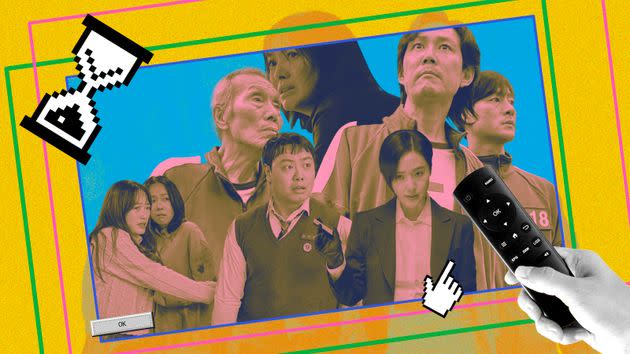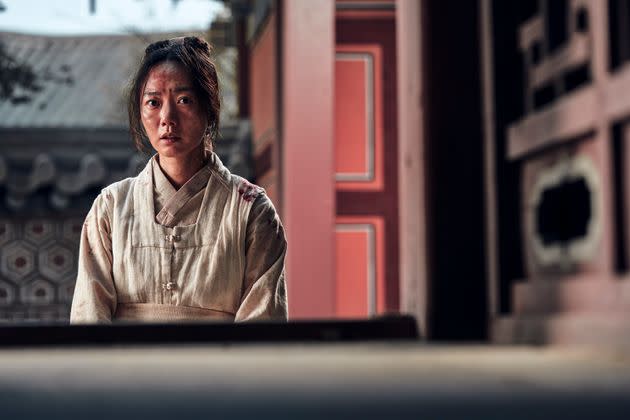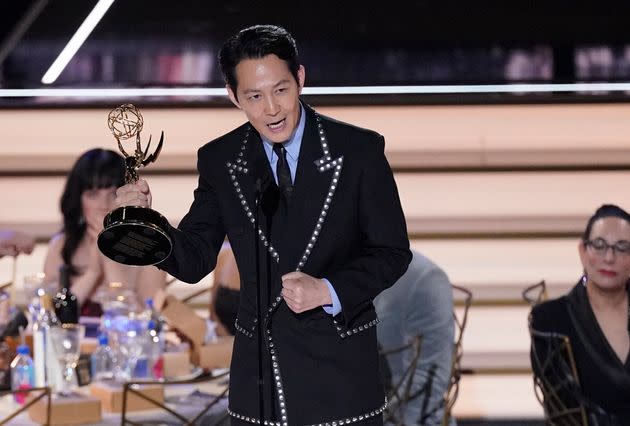Inside The Radical Transformation Of The Korean Drama

K-dramas, or South Korean scripted TV shows, have long been captivating international audiences. Their popularity has skyrocketed in recent years, most notably with the 2021 success of “Squid Game,” which remains Netflix’s most-watched series. Today K-dramas make up some of the best-performing content on various streaming platforms, regularly occupying several of the spots on Netflix’s weekly Global Top 10 list of the most-watched non-English language TV shows. Last year, nine out of the top 15 international originals on Disney+ were Korean. The thought-provoking sci-fi K-drama “Yonder” was Paramount+’s most-watched international series in the U.S. upon its release. The list goes on.
Global streaming services continue to deliver Korean shows in response to overwhelming demand — with Netflix announcing last year that it will invest $2.5 billion in Korean content over the next four years and Disney+, Paramount+ and Prime Video each expanding its Korean slate. However, many longtime K-drama fans worry that these platforms might be eroding some of the defining characteristics that drew them to Korean TV in the first place — especially the general lack of violence, sex and nudity that made K-dramas a welcome, family-friendly alternative to Hollywood fare. Many of the most recent globally successful Korean series — such as Netflix’s “Squid Game,” “All of Us Are Dead,” “The Glory” and “Parasyte: The Grey;” Disney+/Hulu’s “Moving” and “A Shop for Killers;” and Paramount+’s “Bargain” feature violent, gory and/or sexually explicit content that would’ve been unthinkable less than a decade ago.
But as these streaming platforms release Korean titles for international audiences, many viewers are asking how these global streamers are impacting the kinds of K-dramas we’re seeing today. While streaming has democratized access to K-dramas worldwide, it’s also brought about significant changes to their content, structure and even production process, resulting in a radical transformation of the K-drama landscape and a merging of K-cinema with Korean TV.
Many K-drama fans say that with the rise of streaming, they’ve noticed a corresponding uptick in the number of Korean shows featuring violent and/or sexually explicit content. Some have even taken to online discussionforums and blogs to air their concerns over this trend.
“That is one of the biggest changes I feel I am having to adjust to and one of the reasons I’m watching less K-dramas now,” said Carol Markwei, a Vancouver-based fan who’s been watching K-dramas for 27 years and runs the kdramasmusings Instagram account and a podcast of the same name. “My feeling on this change is really complicated. I am happy for the industry, writers and actors because the expansion of the range of content on TV affords them new roles and stories to explore and play within. At the same time, I fear for a time when graphic content is used to drive plot and not character development, because that’s why I have stuck to K-dramas this long, and what I believed K-dramas did well. You could see, feel and empathize with the emotions the characters were going through.”

But many others are welcoming the recent proliferation of edgy Korean TV shows, especially those featuring more violence, suspense and terror.
“I would absolutely love to see more thriller and horror in Korean dramas,” said Nyeasia Pippin, a homemaker living in Arkansas. “Korean horror/thriller is really in a league of its own. It brings a level of anxiety that makes you actually feel like you are in it yourself!”
Julie Vooys, a special education teacher in Massachusetts, is another fan who enjoys these darker K-dramas, citing “Moving,” “Vigilante” and “Gyeongseong Creature” as some of her recent favorites.
“Horror/thrillers is one of the reasons I continue to be engaged in K-dramas,” she said. “While romantic comedies were the reason I got into K-dramas, and though I still enjoy them, they are more predictable and comforting. The horror and thriller K-dramas are more exciting and mysterious.”
Whether fans love or hate K-dramas that showcase graphic content, one thing is clear: They’re markedly different from the typical K-dramas audiences were familiar with before streaming disrupted the Korean TV industry.
To understand how K-dramas have evolved in the streaming era, it’s important to first look at how they used to be distributed and consumed.
The Ways People Watch K-Dramas Have Changed
In the past, K-dramas were shown exclusively by South Korean broadcast and cable TV channels and later sold to overseas markets (sometimes at a steep discount), whichhelped promote the spread of Korean content across Asia, Africa, the Middle East and Latin America. In regions of the U.S. where K-dramas weren’t aired, sometimes the only way to watch them was to rent a bootleg VHS tape from your local Korean grocery store.
Later, with the advent of broadband internet, eager fans could stream or download popular Korean shows from illegal websites advertised through word of mouth. K-dramas became more widely accessible in the 2010s whenearly streaming platforms like Viki and the now-defunct DramaFever made it possible to watch them legally with English subtitles. In addition, Netflix and Hulu subscribers could view a handful of Korean programs thanks to distribution agreements with Viki and DramaFever. A 2014 report by the Korea Creative Content Agency estimated that about18 million Americans were already watching K-dramas at the time.
Netflix launched in South Koreain 2016 amid a growing global interest in Korean pop culture. By the time it premiered its first original K-drama “Kingdom” in early 2019, Netflix was already availablein over 190 countries, allowing it to push the Korean series directly to a massive worldwide audience without going through a distributor or any other intermediary.

In the age of streaming, anyone living in a country where Netflix operates can easily access its vast library of Korean content (though some of its licensed titles are available only in select markets). Between 2019 and 2021, U.S. viewership of K-dramas on Netflix increased by over 200%, while global viewership soared sixfold over the same time period.
David Tizzard, Ph.D., a professor at Seoul Women’s University who hosts the “Korea Deconstructed” podcast and regularly contributes to The Korea Times, underscores the huge role that Netflix has played in introducing Korean TV shows to the uninitiated.
“With K-dramas, previously loads of people watched them, but your average run-of-the-mill person in, say, the United Kingdom was not watching a K-drama,” he said. “And so what Netflix has done is, your average content viewer is now watching [K-dramas] because of Netflix.”
Since Netflix’s success with K-dramas — especially with “Squid Game” — other major OTT platforms such as Disney+, Apple TV+ and Paramount+ have followed suit, releasing K-dramas to a global audience. Prime Video launched its first original Korean series in 2017 and has recently ramped up its investment in Korean content. Thanks to these global streaming services, even shows that weren’t very popular with Korean audiences can now hit it big internationally, as was the case with the 2020 fantasy romance “The King: Eternal Monarch,” which endured harsh criticism from Koreans yet was well-received by viewers in other Asian countries and the U.S.
The Diversification Of K-Drama Formats
The advent of streaming popularized new formats for K-dramas. Prior to Netflix’s arrival in South Korea in 2016, only a small handful of K-dramas — such as Korean cable channel OCN’s “Vampire Prosecutor” and “Quiz of God” — went on for more than one season.
Once Netflix became available in Korea, however, “many Koreans suddenly started to watch American dramas on Netflix and learned the season system,” said Dal Yong Jin, Ph.D., a distinguished professor of communications at Simon Fraser University. In recent years, some of the most popular K-dramas across streaming and linear TV (such as “Hospital Playlist,” “D.P.,” “The Penthouse,” “Sweet Home” and many others) have gone on for two or more seasons, allowing audiences to engage with their favorite characters and storylines for longer periods of time.
Previously K-dramas also usually lasted for 16, 20 or 24 episodes, though some shows — especially daily soap operas and family and period dramas — often ran for 50+ episodes (“Emperor Wang Gun” holds the record for the longest historical K-drama with 200 episodes, while the slice-of-life family drama “Country Diaries” clocked in at a whopping 1,088 episodes, making it the longest-running series in Korean TV history). However, streaming platforms have since given rise to K-dramas with fewer episodes (usually between 6 and 12) per season — a practice that has carried over into Korean broadcast and cable TV networks as well, which now air shorter series alongside those that follow a more conventional format.
Lately, we’ve also seen the K-drama industry experiment with another format: splitting a single season into two parts, partly to build anticipation and keep the conversation going around a particular show. Recent hit K-dramas like “The Glory,” “Gyeongseong Creature” (whose second season will be premiering later this year), “Death’s Game” and “My Dearest” have all done this with great success, hinting that this new model will likely continue in the future.
Why We’re Seeing More K-Dramas With Graphic Content
The impact of streaming on K-dramas isn’t limited to their structure but extends to their content. Traditionally, most K-dramas were romances, sageuk (period pieces) or family dramas, but in recent years they have increasingly branched out into other genres. “Romance, or romantic dramedy, has been the major genre in K-drama. However, due to Netflix, zombie, survival, thriller and horror have become popular, which is unprecedented,” Jin said.
“Now there are so many genres, like monsters for ‘Sweet Home,’ zombies for ‘All of Us Are Dead’ and ‘Kingdom.’ There’s even teenage crime, like ‘Extracurricular,’ and sci-fi like ‘The Silent Sea’ and ‘The School Nurse Files,’” said Areum Jeong, Ph.D., assistant professor of Korean studies at Arizona State University.
And it’s not just Netflix, either. Other platforms have been pumping out all kinds of boundary-pushing shows, from Paramount+’s serial killer masterpiece “A Bloody Lucky Day” to Disney+/Hulu’s superhero smash “Moving” to the steamy romantic dramedy “Hit the Spot” (which explores taboo topics like sex and masturbation and is available on Viki) — just to name a few examples.

But if you’re wondering why K-dramas seem to be getting more thrilling, chilling and titillating, it’s not that K-drama creators were previously uninterested in crafting bolder and more unconventional stories.
They simply weren’t allowed to do so, to a large extent.
K-dramas aired on South Korean TV still generally refrain from showing graphic content due to guidelines imposed by the country’s Broadcasting Act and enforced by the Korea Communications Standards Commission. A scene involving a couple getting hot and heavy or a hapless victim being hacked to death would likely draw viewer complaints, which the commission would then review and decide whether to issue any warnings or penalties. Because displaying inappropriate content on TV comes with such high risk, K-dramas have long been known for avoiding nudity, sex and excessive violence — a key reason why they have been able to amass a loyal international fanbase over the years, especially in socially conservative countries where more explicit Western shows may be frowned upon or banned altogether.
Streaming giants like Netflix and Disney+, on the other hand, aren’t bound by any rules regarding what can and cannot be shown in a Korean series.
“Global OTT platforms are not under national regulations; therefore, the Korean government cannot ask global OTT platforms to respect local norms,” Jin said. This relative lack of oversight has led to the introduction of more extreme and provocative shows on Netflix and other streamers, with plenty of K-dramas now featuring sex scenes (like in “Squid Game,” “My Name” and “Somebody”) and violence and gore (again, think “Squid Game” and most other Korean shows that have garnered widespread media coverage in the West).
“Netflix is giving a platform for Korean content that would otherwise struggle to be on mainstream television,” Tizzard said. “It’s hard to put the violence of “All of Us Are Dead” on domestic Korean television. I think [Netflix] is giving Korean dramas a safe space — a home that they otherwise might not have found.”
Traditional K-Dramas Still Dominate
Still, programs with graphic content make up only a small fraction of K-dramas produced every year. “Although many local cultural creators are developing new genres, the majority of them still focus on traditional genres,” Jin said.
Though graphic and gory K-dramas tend to receive the most attention from mainstream Western media outlets, viewership data shows that conventional K-dramas — especially romance and period pieces — continue to resonate with audiences around the world. Netflix co-CEO Ted Sarandos revealed last year that over 90% of viewers who watch K-romance on Netflix are based outside of South Korea. Six out of the 10 K-dramas that made the Netflix global Top 10 list of non-English TV shows between January and March of this year fall under the romance category (note that “Captivating the King” would be considered as a historical drama as well). Over on Prime Video, the recent time slip romantic drama “Marry My Husband” became the streamer’s most-watched series worldwide during part of its run. (Although the show contains some suspenseful and spicy moments, there’s nothing overtly graphic.)
“We’ve already seen that these shows could be very popular — romance series like ‘Crash Landing on You’ or ‘Hometown Cha-Cha-Cha’ or ‘The King’s Affection,’” Jeong said. “I think these types of shows will still appeal to a global audience because they hold universal values and morals that people identify with, like community, family love and family values, bettering yourself and working hard.”
The ultimate takeaway here is that K-dramas as a whole aren’t necessarily becoming more violent or sexually explicit — rather, we’re seeing a greater diversification of genres in Korean TV, with some shows attracting new viewers who previously didn’t care for K-dramas and others appealing to those who prefer more traditional, wholesome fare.
“That’s the beauty of K-dramas now: There is a show for every fan,” Markwei said.
Blurring The Line Between K-Cinema And K-Drama
Experts also say that while most K-dramas in the past have been G-rated by Western standards, Korean films, on the other hand, have a long track record of featuring violent and sexual content (think Park Chan-wook’s “Oldboy” or Kim Jee-woon’s “I Saw the Devil,” for instance).
“There’s already a rich history of Korean filmmakers making very dark, very critical films about society and culture, such as Lee Chang-dong’s ‘Peppermint Candy,’ which came out in the late 1990s, and Bong Joon-ho’s ‘Memories of Murder,’ which came out in the early 2000s,” Jeong said.
However, the rise of streaming services — especially Netflix — has fundamentally destroyed the barrier that previously separated the worlds of Korean cinema and Korean TV. Some insiders even argue that Korean original TV series on Netflix are more akin to films than K-dramas.
“We Koreans in the film industry do not consider [Netflix original series] as a K-drama,” said Jonathan Kim, an award-winning veteran movie producer who’s twice served as the chair of the Korean Film Producers Association. Until recently, most Korean scripted series were either shot the same week they aired or only partially filmed before their premiere — a frantic pace that likely would have deterred many filmmakers from trying their hand at TV. Kim explains that movie directors probably couldn’t keep up because they were used to shooting more slowly.
“Whereas with Netflix, you don’t have to shoot it the same week [it airs] — you have to finish the whole thing in advance,” he said.
That fact alone has opened doors for Korean filmmakers to venture into creating Korean TV shows via Netflix and other major streamers, allowing audiences to witness their vision spill over onto the small screen. “Squid Game” was director Hwang Dong-hyuk’s first foray into TV; before that, he was known in South Korea for directing a wide range of commercially successful films, including the disturbing 2011 crime drama “Silenced.”
Similarly, Yeon Sang-ho, who directed and co-wrote Netflix’s recent Korean hit “Parasyte: The Grey,” had never directed a TV series prior to the Netflix original “Hellbound,” but he had already made his mark as an A-list filmmaker with movies like the zombie blockbuster “Train to Busan.” The darker themes, graphic content, and action-packed storytelling found in shows like “Squid Game,” “Hellbound” and “Parasyte: The Grey” are more reflective of Korean cinematic traditions than of typical K-dramas.
“The kinds of subjects we can portray — we can do any subject with movies, whereas with TV, it’s a bit conservative. That’s why Netflix series are a lot closer to movies than TV dramas,” Kim said. “It’s like watching a really long movie.”
Over the past several years, platforms like Netflix have increasingly upended the entire production process for K-dramas, further blurring the line between Korean film and TV. According to Kim, most K-dramas are pre-produced these days, and “OTTs have a lot to do with it.”
A spokesperson at Studio Dragon, the production powerhouse behind many of today’s most popular K-dramas, shared that nowadays, even K-dramas that are shown on broadcast and cable TV usually wrap up filming before the first episode airs since most of them are simultaneously streamed on local and/or global OTT platforms.
It would be impossible to overstate Netflix’s role in this growing convergence between Korean film and TV.

“Ever since the global popularity of ‘Squid Game,’ people working in the Korean film industry have been drawn to making TV shows because they’re getting global attention [via Netflix]. Now they want to be the next Hwang Dong-hyuk or a world star like Lee Jung-jae, so they’re all flocking to Netflix,” said Park Ki-yong, a film professor at Dankook University’s Graduate School of Culture, Arts and Design and the former chair of the Korean Film Council.
But more importantly, Park revealed that many Korean film directors began creating TV shows largely out of sheer necessity.
“Between May 2022 and October 2023, there were about 110 feature films that weren’t able to be released in theaters due to the COVID pandemic,” he said. “The total amount of investment in these films was about 600 billion won (roughly $438 million) altogether, and that money could not be recovered because it was all tied up. That meant that money could not be invested in new projects. So all the movies that were supposed to be feature films but couldn’t get funding — they all went to Netflix and got investment from Netflix to turn them into TV series. This has, in a sense, become a trend.”
How Streaming Continues To Disrupt The Korean TV Industry
The growth of global streaming platforms has been a godsend for Korean creatives looking to tell fresh, bold stories that require significant time and resources to bring to life.
“I see it as a really profitable partnership where filmmakers can get funded,” Jeong said. “There’s a bigger budget, so they can make their stuff on a bigger scale. You see how the images are so high quality, and there’s a lot of creative freedom to showcase stories that would be gatekept on mainstream channels or cable channels in Korea.”
But for all the international success and renown these streamers have brought to the Korean TV industry, there are also major downsides.
“There are discussions on IP rights and whether Korean creators are being compensated fairly,” Jeong said. Netflix doesn’t pay residuals to Korean actors, writers and directors, and creators often have to give up IP rights to Netflix in exchange for generous production budgets and global reach and promotion.
Furthermore, streamers like Netflix and Disney+ have poured massive sums of money into their Korean projects, driving up production costs for K-dramas across the board.
“Shows that used to cost less than $1 million an episode now average $2 million or $3 million and sometimes cost as much as $5 million,” according to a recent Bloomberg article. Local TV networks struggling to keep up have resorted to releasing fewer K-dramas while relying more heavily on unscripted shows. And while domestic OTT platforms have launched a slew of high-caliber TV shows in recent years to compete against Netflix, none of them have managed to attract a sizeable subscriber base, spurring the two largest local Korean streamers — Tving and Wavve — to discuss the possibility of a merger (if it goes through, the combined streaming service would likely overtake Netflix’s market share in Korea).
Only time will tell what the K-drama landscape will look like in the future. However, as local players and global OTT giants continue to battle it out, K-drama watchers can only hope that the competition will lead to a wider variety of higher-quality programming in the years to come.

 Yahoo News
Yahoo News 